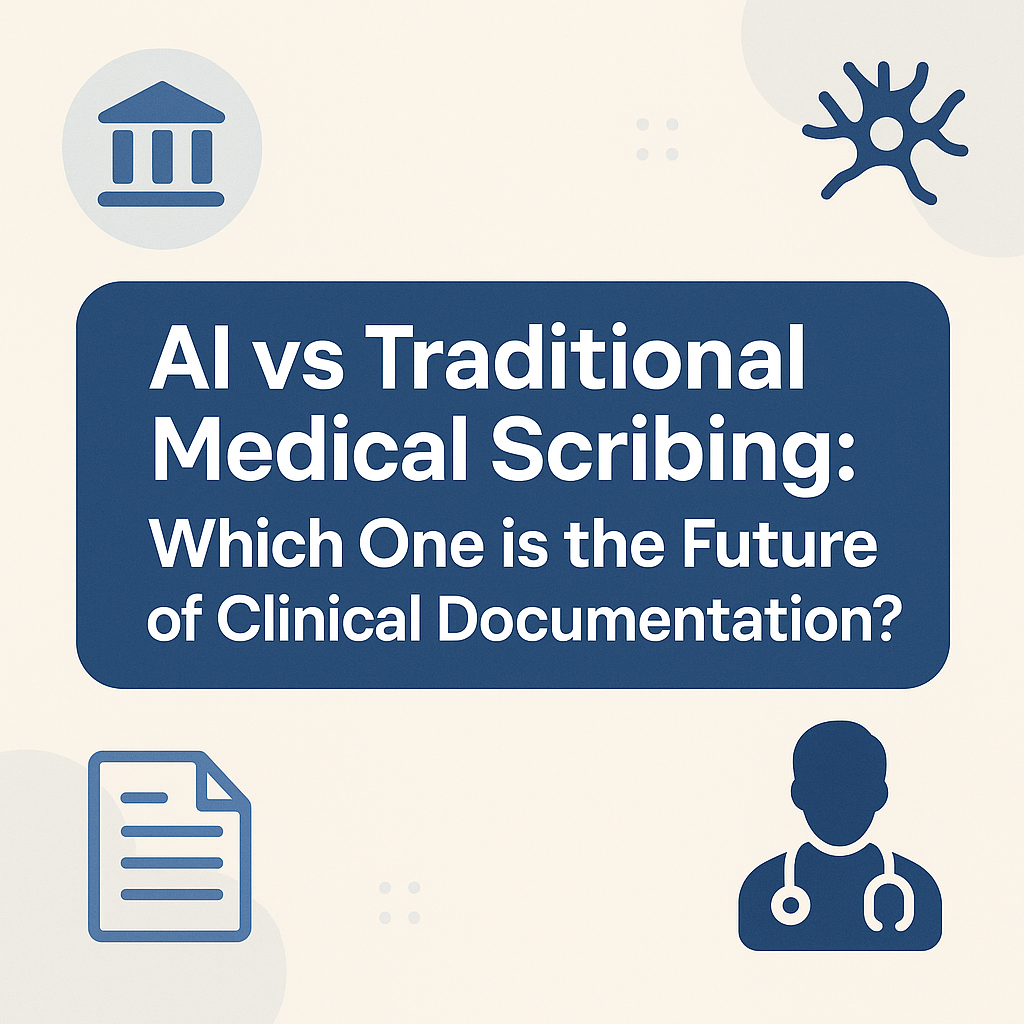Updated on: June 26, 2025
In today’s high-paced healthcare landscape, one question is on the minds of physicians and practice managers alike:
Should we stick with traditional medical scribes or embrace the power of AI-driven scribing?
As documentation demands increase and clinician burnout becomes an urgent issue, the choice between AI vs traditional medical scribing is more than a technical debate—it’s a strategic decision impacting quality of care, efficiency, and physician satisfaction.
In this comprehensive guide, we break down the core differences, benefits, limitations, and use cases of both models—helping you determine the best solution for your practice.
What is Traditional Medical Scribing?
Traditional medical scribes are human professionals—often pre-med students or trained paraprofessionals—who accompany physicians during patient visits (in-person or virtually). They document patient encounters in real-time into the Electronic Health Record (EHR), enabling the physician to focus on care rather than keystrokes.
Pros:
-
Human context interpretation
-
Adaptive in complex or nuanced cases
-
Familiarity with clinical environments
Cons:
-
Costly (hourly wages, training, turnover)
-
Limited availability (especially after hours)
-
Scalability issues
-
Human error and inconsistency
What is AI Medical Scribing?
AI medical scribing uses artificial intelligence—often powered by natural language processing (NLP) and machine learning—to automatically transcribe, structure, and populate EHRs based on doctor-patient conversations.
Platforms like DocScrib are leading the way by offering ambient listening and real-time charting capabilities tailored to specialty-specific workflows.
Pros:
-
24/7 availability
-
Scalable and cost-efficient
-
Structured, consistent documentation
-
Seamless integration with EHRs
Cons:
-
May require occasional human oversight
-
Learning curve for new users
-
Potential data security concerns (mitigated by HIPAA compliance)
Side-by-Side Comparison
| Feature | Traditional Scribes | AI Medical Scribes (e.g., DocScrib) |
|---|---|---|
| Availability | Business hours | 24/7 |
| Cost | High (salaried/hourly) | Lower (subscription-based) |
| Accuracy | Depends on scribe skill | Consistently high with NLP training |
| EHR Integration | Manual or semi-automated | Fully automated |
| Scalability | Limited | Instant scalability |
| Burnout Reduction | Moderate | High impact |
| Specialty Adaptability | Variable | Tailored AI models for each specialty |
Key Advantages of AI Medical Scribes
1. Speed and Efficiency
AI scribes complete notes in real time, reducing lag between patient visits and EHR documentation.
2. Cost Savings
Compared to traditional scribes, AI systems cut costs by 40–60%, especially in high-volume practices.
3. Reduced Errors and Omissions
AI models trained on specialty-specific language minimize charting inconsistencies and improve documentation quality.
4. Burnout Prevention
Less time documenting = more time with patients and family. Tools like DocScrib are directly linked to reduced physician fatigue and increased job satisfaction.
When Traditional Scribes Still Make Sense
While AI scribes are rapidly evolving, there are scenarios where traditional scribes still add value:
-
Highly complex or rare cases requiring human judgment
-
Settings with poor audio capture or infrastructure
-
Physicians resistant to tech adoption or working with legacy systems
Still, many practices are adopting a hybrid model—AI scribes first, human oversight where needed.
How AI Improves Clinician Happiness
Clinician burnout has reached crisis levels. Between administrative overload, late-night charting, and EHR fatigue, physicians are leaving practice or reducing hours at alarming rates.
AI Medical Scribes for happier clinicians isn’t just a tagline—it’s a measurable outcome. Studies show:
-
80% of clinicians report less stress when using AI scribes
-
Documentation time drops by up to 76%
-
Patient satisfaction increases as physicians are more present
👉 Want to experience this difference? Try Docscrib in action.
The Docscrib Advantage: AI Medical Scribe for Happier Clinicians
At DocScrib, we’re building the most intuitive, accurate, and clinician-friendly AI scribe solution in the market. Whether you’re in cardiology, primary care, pediatrics, or emergency medicine—our platform adapts to your style.
Features:
-
HIPAA-compliant ambient scribing
-
Real-time EHR charting
-
Support for over 25 medical specialties
-
No-code EHR integration
-
Automated SOAP and H&P note generation
✅ Explore Docscrib
✅ Book a Free Demo
Conclusion: The Future of Medical Scribing
The debate between AI and traditional medical scribes isn’t a battle—it’s a shift. AI isn’t replacing clinical empathy or human nuance. It’s removing the friction, fatigue, and frustration that have long plagued healthcare documentation.
The future belongs to smart clinicians using smart tools.
If you’re ready to reduce burnout, reclaim time, and refocus on care, now’s the time to adopt AI-powered scribing with DocScrib.
